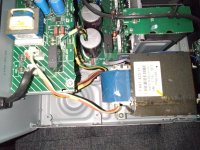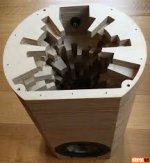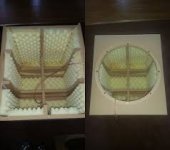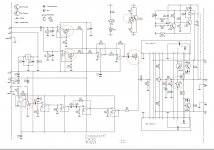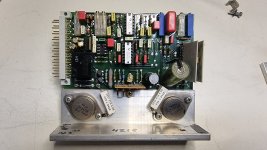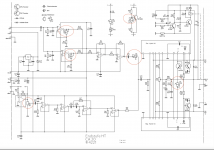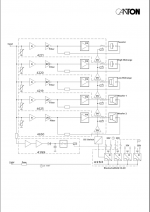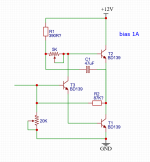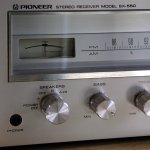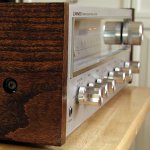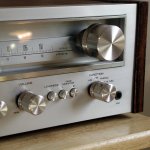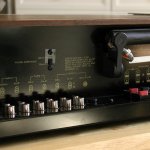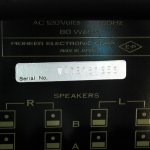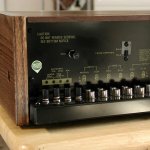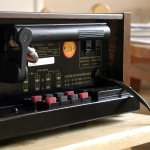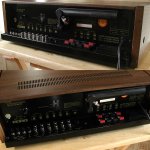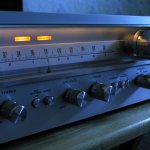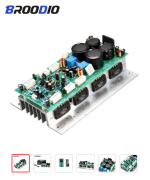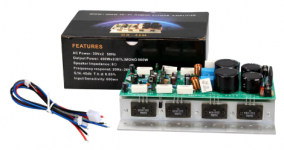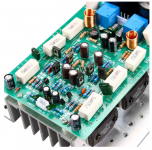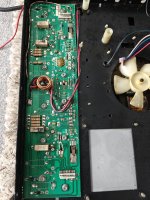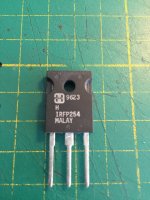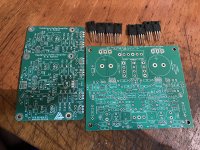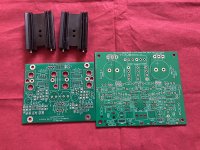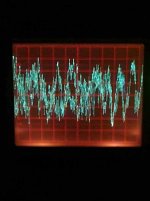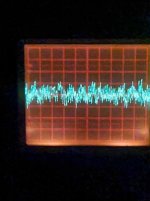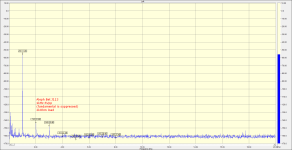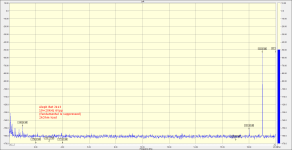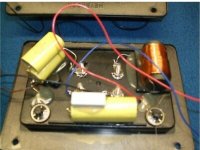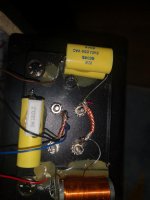My latest project is out on Reverb.com and it's been a very fun and inspiring one indeed.
A few years back I was doing quite a bit of repair work and learned that the region of Washington state were I lived at the time lacked anyone with my audio electronics skills or at least ones willing to do repairs. This led to becoming the local music store repair guy and what an adventure that turned out to be. At some point a discussion with my wife led to the interesting idea of taking my favorite repairs, the vintage stereos, and turning them into a different sort of side job. For some reason Pioneer turned out to be my favorite and we found several specimens on ebay that were seriously ready for some love.
Then an interesting guitar effects pedal related collaboration came along and that put off the stereo project for few years but now I'm getting around to restoring those Pioneers with great care.
This SX-550 opened my ears well beyond what I thought it would. In fact, it's now become quite the friend in the office portion of my lab where my burn-in process for this unit ended up being far more extensive than I thought it would be. I'm not easy to please regarding audio and I can tell you that I love to power this one up every morning. I also discovered that an FM station in my area plays 70s music all day Saturday and that proved to be interesting. For the first time in a very long time I'm listening to FM again. Weird. I'm even listening to the few vinyl records that I still have.
The SX-550 is now on Reverb.com!
https://reverb.com/item/82314088-pioneer-sx-550-1976-brushed-aluminum-oak-veneer
Pioneer SX-550 – Manufactured September 1976
Restoration by Retrofier Labs
The Restoration Details:
Complete Electrolytic Capacitor Replacement or “Recap” - This includes the substitution of several small value electrolytic capacitors with equivalent film capacitors for low distortion and reliability.
All Controls Cleaned and Lubricated - All of the potentiometers and switches were thoroughly cleaned and lubricated using air and Deoxit.
Solder Connections - The entire system was visually inspected and any suspect solder connections/joints were reworked.
Dial Cord Replaced - The dial cord in stereos of this vintage are often intact but slipping and making creaking sounds as they have lost their flexibility with age. The cord in this unit was replaced with a proper equivalent of the original and the pointer track was also lubricated for smooth and quiet tuning.
Tuning Control Shaft Assembly Rebuilt - The big knob with the heavy flywheel that gives the tuner it's 1970s feel is mounted on a brass shaft/sleeve assembly that often looses it's lubrication over time and sometimes completely seizes. It must be disassembled, cleaned, lubricated, reassembled, and carefully adjusted for the appropriate shaft end-play. This has all been done for this unit and it feels very much as it would have in 1976.
Dial Lamps Replaced - Quite often you will see old stereos with the lamps replaced with LED equivalents and that works, but I prefer incandescent lamps that give the vintage glow and maintain the original look as much as possible. The lamps I use run cooler and last longer than the originals and don't flicker or generate radio interference. Many of the original Pioneer lamps are are still working after nearly 50 years and the replacements in this unit can in theory run much longer.
Power Amplifier restoration and upgrades:
- Transistors - The output and driver transistors were replaced/upgraded using much higher performance modern versions that significantly lower the distortion relative to the original specifications.
- Stability Margin Corrected - The new transistors having more bandwidth and less capacitance than the originals means that the amplifier's stability margin must be corrected and the appropriate changes were made. The amplifiers are free of any high frequency stability problems.
- Bias Controls Modified/Corrected - For unknown reasons the original SX-550 amplifier bias trimmer rotation is reversed and they allow a far too high Vq voltage that results in a quiescent current that can lead to power amplifier failure. This maximum happens at the full counter clockwise and thus counter intuitive position. The necessary modifications were made to reverse and limit the trimmers to prevent future problems. This also protects the amplifiers from overheating should the trimmer potentiometer’s wiper become an open circuit from shock, oxidation, or contamination.
- Amplifier Bias Set and Distortion Characterized - The power amplifier bias was set using a distortion analyzer measuring a worst case THD+N of 0.008% @ 1kHz with the output just below clipping and loaded with a non-inductive 8 Ohm resistor.
Note: The SX-550 is rated for 8 Ohm loads only and this is easy to violate with the A and B speakers on at the same time. Be sure that the total load is always 8 Ohms or more. It should also be noted that short circuits while signal is applied can destroy these power amps immediately.
The original SX-550 is rated at 0.3% THD @ 20 Watts and 0.07% @ 10 Watts. This rather high and inconsistent distortion was mostly due to the poor quality (by today’s standards) output transistors causing significant large signal distortion that has been removed from this unit using much higher quality modern devices and proper bias adjustment using a distortion analyzer. The sound is now very pristine.
Power Switch Rebuild - The Pioneer SX-450 and the SX-550 had a rotary power switch that often developed arcing problems after many years of use and this caused behavior that can be very misleading as the symptoms suggest other problems.
The good news is that these were very well made switches that can be disassembled, cleaned, lubricated, and reassembled to end up with essentially a new switch. The contacts have generous material to be resurfaced and should last another 48 years. This unit's switch was not an exception and after the rebuilding, it works like new.
Real Oak Veneer! - The Pioneer SX-450 and SX-550 and likely others have metal top covers that are almost always like new. For some reason the material used to simulate wood for the top piece seems to last forever.
The particle board end caps are another matter. These are always in poor to very bad condition. My solution for this problem is to strip away all of the plastic material and refinish them with real wood veneer. This gives the end caps a truly "high end" and better than new appearance. I stain them to reasonably agree with the color of the top and and finish them off with water based polyurethane. This particular unit has Oak veneer and looks really cool.
Tuner Alignment Tested - The AM and FM tuners in the SX-550 use ceramic filters and what alignment is adjustable is rarely off. Nonetheless, it's good to test for any significant error and I do. This unit's tuner could not be improved by any adjustment and it sounds very good. All is well.
Headphone Output Recalibrated - The headphone output of the SX-550 as with most others of the era were designed for 8 Ohm headphones which today is not so common. Older stereos like this used a simple technique of dropping the power amplifier output with a resistor to get the headphone output to a reasonable level. The problem is that most headphones have much higher impedance these days and to complicate things further, there is no standard for headphone impedance(that I know of) and the range is pretty crazy at about 8 to 300 or more Ohms.
What I decided to do for this SX-550 is change the resistor to be ideal at the 64 Ohms of my Sennheiser HD 280 headpones which are very popular and sound very good. This is not to say that others will not work, it’s a matter of the volume level and with the range of the SX-550’s volume control there shouldn’t be problem for most headphones.
Cleaning and General Condition - The exterior of this unit was throughly cleaned but not altered in any way. All of the paint and brushed aluminum surfaces are original. All of the nicks, scratches etc. are very small and not generally noticable. Overall it's almost like new. The glass is in pristine condition and the black printed lettering on the front panel is incredibly free of defects. A very well preserved stereo that's nearly 48 years old.
Output Power - The SX-550 is rated at 20 Watts per channel @ 8 Ohms and it isn’t rated for lower impedances.
But how loud is that and what do you really need?
Where this Pioneer model is concerned I can share my experience because I use one every day. My SX-550 is connected to some nice but very inefficient bookshelf speakers situated a few feet away and I have carefully measured the output power under various listening conditions. What I discovered was that I use even less power than thought.
First I should point out that the only case where I might consume the entire 20 Watts of the SX-550 is when I hear a good song on FM or maybe want to play along with a song and crank it up a bit. The peaks in this case can get close to 20 Watts while the nominal or average is about 300 mW or 0.3 Watts. My perception of the loudness at this level is that I would not go this loud if I lived in an apartment and I’m talking about 5 inch woofers. It fills the room surprisingly well.
My general conclusion from these tests is that 20 Watts is plenty for my use and most of the time I only need 5 Watts for peaks, not 20.
This is simply an example based on my personal opinion to give some idea of what 20 Watts means in a practical situation at home with modest speakers. It’s really a very useful level of power and does not leave me wanting. With larger and more efficient speakers which also have more bandwidth, 20 Watts is more than enough from my experience.
Vinyl Record Playback? - The moving magnet preamp/EQ had it’s electrolytic capacitors replaced with film types and is now within specifications for the SX-550. By listening, it sure seems to work well. I played several records ranging from horrible scratchy things to wonderful clean specimens and they all seem to sound as they should.
What Did It Cost New? - In 1976 the SX-550 sold for $250.000 USD which in 2023 USD would be $1278.44.
